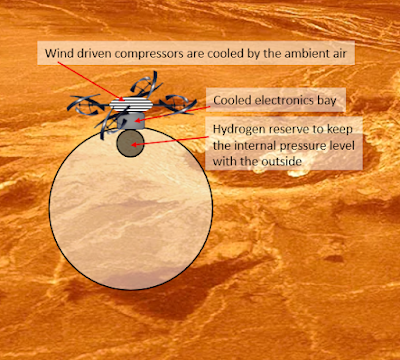Venusian cold polar vortex surrounding the warmer polar vortex opens a possibility of a permanent floating research base on Venus. In order to explore the area further, an airship can be send. The airship will be a floating balloon. Dense atmosphere of Venus has higher lifting power even at higher altitudes.
The airship will have high temperature resistant balloon envelope made of carbon nanotube fibers to create the lift. The balloon will be filled with hydrogen gas. The top of the airship will have four vertical wind turbines that drive four compressors. The compressors will be air cooled by the ambient air. The idea is to utilize a special coolant that would work at Venus temperatures, above 400 degrees Celsius, to cool down the electronics bay of the balloon. Four independent wind driven compressors will allow redundancy as well as induce controlled drag for maneuvering the airship. This is a complex design that should be light and strong. Use of silicon carbide electronics will allow higher temperatures than the silicon counterparts. Advanced Peltier modules will be used to generate electric from the temperature difference between the electronics bay and the ambient air.
The airship will have a high-pressure hydrogen reserve to keep the internal pressure within the balloon level with the outside. This will also allow the airship to change its elevation. The hydrogen reserve will determine the operation duration of the airship. Once the reserves deplete, the airship will lose elevation. Air is denser at lower altitudes and the lifting power is higher. Therefore, the airship will still stay aloft for quite some time until it crashes on the ground.
The airship's balloon envelope will be coated with a special material and then covered by lead, during transportation from earth. The lead layer will protect the envelop from micro meteoroids. Once the explorer reaches Venus and start descending, the lead will start to melt and the special coating will repel the molten lead away.
The main objective of the airship is to monitor the temperature, air composition and wind speed at different altitudes to find a better location for the floating Venus base.

No comments :
Post a Comment